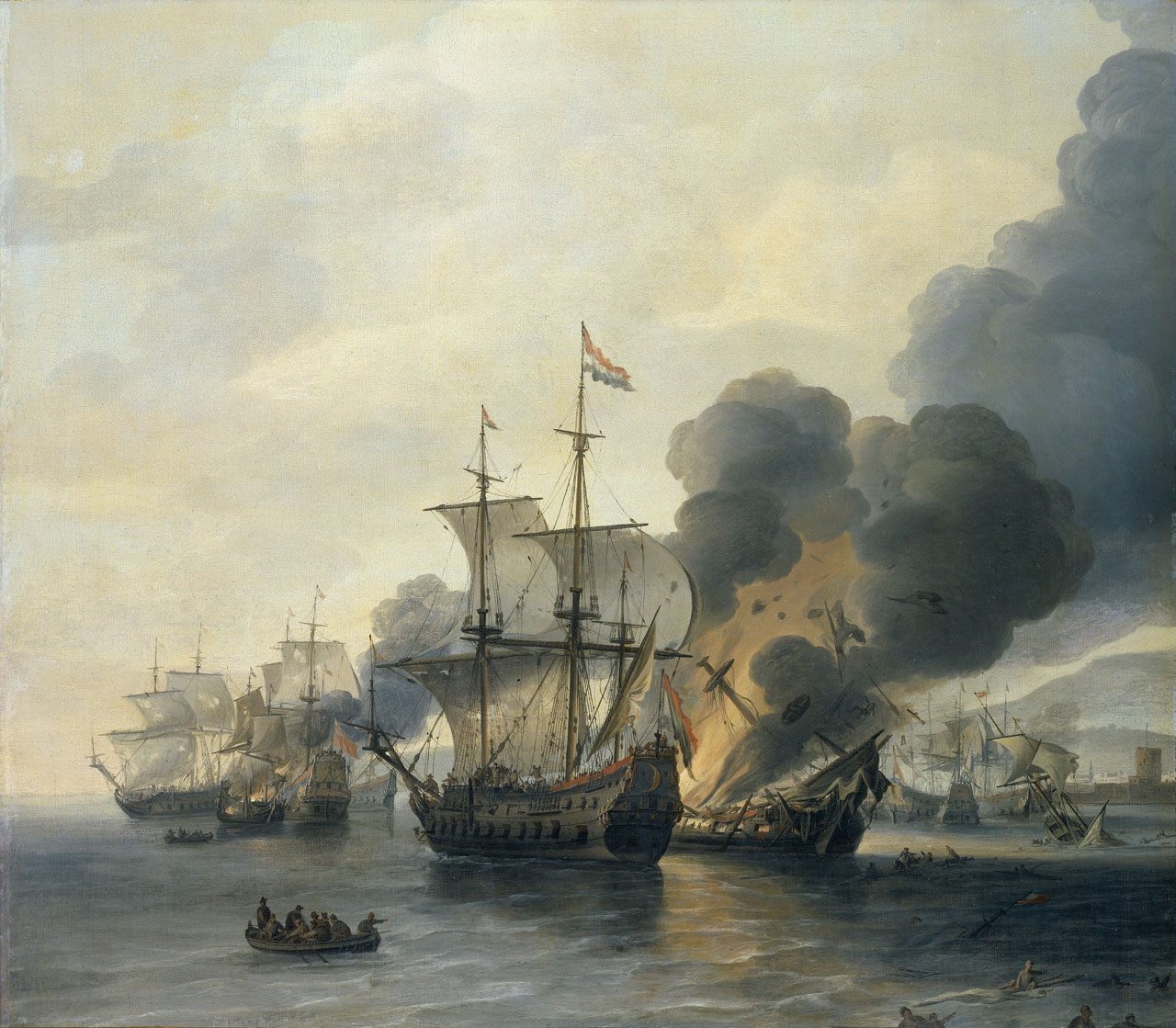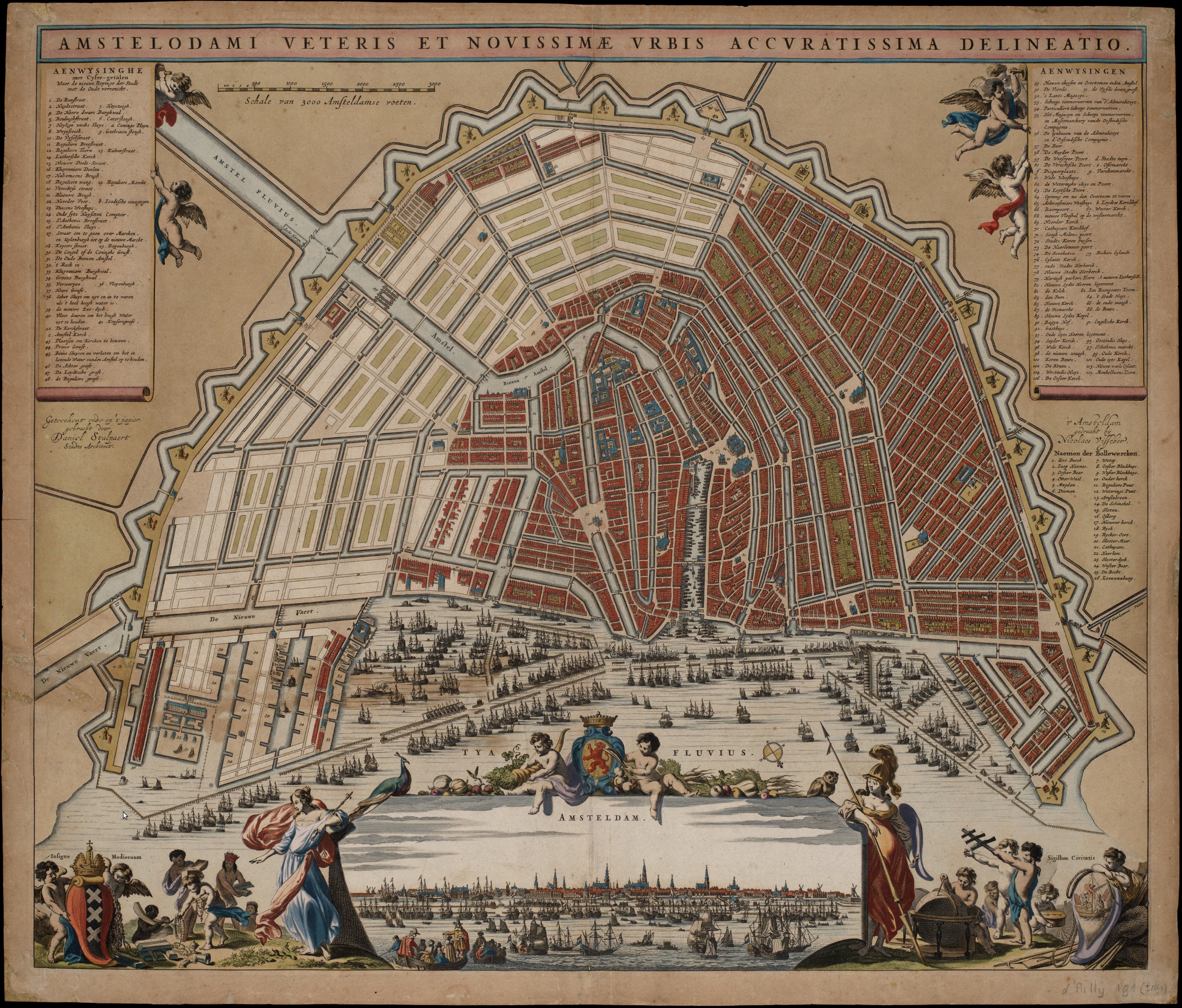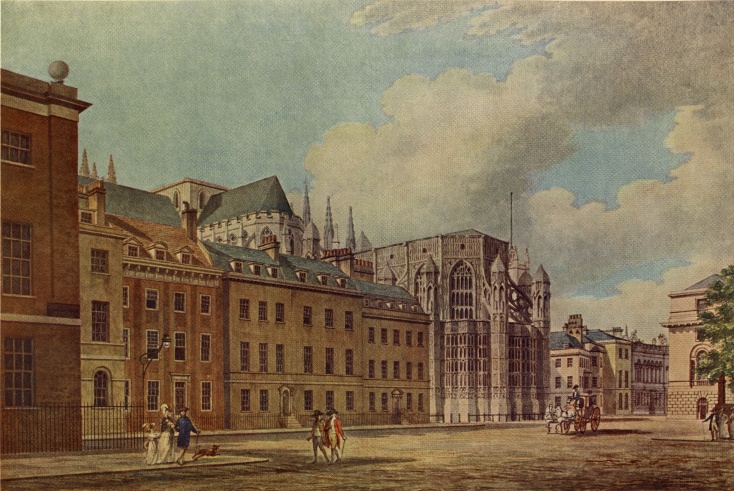|
Trompenburgh
Trompenburgh is a 17th-century manor house in 's-Graveland, the Netherlands, designed by Daniël Stalpaert and built for Admiral Cornelis Tromp, one of the naval heroes of the Dutch Republic. The house is almost entirely surrounded by water and was built to resemble a ship, even with decks and railings. Before the current house was built another buitenplaats Sillisburgh had been built by Joan van Hellemondt The original house dates back to 1654. Through inheritance the house came into the possession of the widow of Van Hellemont Raephorst, who remarried on 25 January 1667, with Cornelis Tromp. The couple redecorated the estate considerably, but the house and their improvements were treasure looted and burned by the French during the rampjaar 1672.Rijksmonument report It was rebuilt from 1675 to 1684 by Tromp, who called it Sillisburgh, after one of his titles. Around 1720, Jacob Roeters came into possession of the estate and renamed it Trompenburgh. Roeters had a gilded plaque wi ... [...More Info...] [...Related Items...] OR: [Wikipedia] [Google] [Baidu] |
Trompenburgh
Trompenburgh is a 17th-century manor house in 's-Graveland, the Netherlands, designed by Daniël Stalpaert and built for Admiral Cornelis Tromp, one of the naval heroes of the Dutch Republic. The house is almost entirely surrounded by water and was built to resemble a ship, even with decks and railings. Before the current house was built another buitenplaats Sillisburgh had been built by Joan van Hellemondt The original house dates back to 1654. Through inheritance the house came into the possession of the widow of Van Hellemont Raephorst, who remarried on 25 January 1667, with Cornelis Tromp. The couple redecorated the estate considerably, but the house and their improvements were treasure looted and burned by the French during the rampjaar 1672.Rijksmonument report It was rebuilt from 1675 to 1684 by Tromp, who called it Sillisburgh, after one of his titles. Around 1720, Jacob Roeters came into possession of the estate and renamed it Trompenburgh. Roeters had a gilded plaque wi ... [...More Info...] [...Related Items...] OR: [Wikipedia] [Google] [Baidu] |
Cornelis Tromp
Cornelis Maartenszoon Tromp, ''Count of Sølvesborg'' (3 September 1629 – 29 May 1691) was a Dutch naval officer who served as lieutenant-admiral general in the Dutch Navy, and briefly as a general admiral in the Royal Danish Navy. Tromp fought in the Anglo-Dutch Wars and the Scanian War. His father was Lieutenant Admiral Maarten Tromp. Biography Early life Cornelis Maartenszoon Tromp was born on 9 September 1629, in Rotterdam, in the historically dominant county of Holland. He was the second son of Maarten Tromp and Dina Cornelisdochter de Haas. His name Maartenszoon, sometimes abbreviated to Maartensz, is a patronymic. He had two full brothers, Harper and Johan.Tromp, Cornelis in ''Nieuw Nederlandsch biografisch woordenboek. Deel 5''. Retrieved 5 May 2009. In 1633, when he was only four ye ... [...More Info...] [...Related Items...] OR: [Wikipedia] [Google] [Baidu] |
Buitenplaats
A buitenplaats (literally "outside place") was a summer residence for rich townspeople in the Netherlands. During the Dutch Golden Age of the 17th century, many traders and city administrators in Dutch towns became very wealthy. Many of them bought country estates, at first mainly to collect rents, however soon mansions started to be built there, which were used only during the summer. History Buitenplaatsen or buitenhuizen could be found in picturesque regions which were easily accessible from the owner's home in town, and they were near a clean water source. Most wealthy families kept their children in buitenhuizen during the summer to flee the putrid canals of the cities and the accompanying onset of cholera and other diseases. Though most buitenhuizen have been demolished, examples are still in existence along the river Vecht, the river Amstel, the Spaarne in Kennemerland, the river Vliet and in Wassenaar. Some still exist near former lakes (now polders) like the Watergra ... [...More Info...] [...Related Items...] OR: [Wikipedia] [Google] [Baidu] |
Top 100 Dutch Heritage Sites
The Top 100 Dutch heritage sites is a list of rijksmonuments in the Netherlands, established in 1990 by the Department for Conservation ( Monumentenzorg, today the Rijksdienst voor het Cultureel Erfgoed). The Top 100 was a selection of historical monuments that were authorized to display the symbol of the Hague Convention of 1954 (the famous blue and white shield, known as the UNESCO shield). The list should not be confused with the UNESCO World Heritage list. The buildings on the list could expect extra security in the context of the policy. The Top 100 list is no longer official, as the extra cultural protection policy is no longer applied. The following Top 100 also includes a list of the most important stained glass, church bells and organs. {, class="wikitable sortable" ! Object !! Built !! Place !! Province !! class="unsortable" , Image , - , Saint Bavo Church , , , , Aardenburg , , ZE , , , - , Castle Amerongen , , 1676 , , Amerongen , , UT , , , - , Ameri ... [...More Info...] [...Related Items...] OR: [Wikipedia] [Google] [Baidu] |
's-Graveland
s-Graveland is a village in the Dutch province of North Holland. It is a part of the municipality of Wijdemeren, and lies about 4 km northwest of Hilversum. The former municipality of 's-Graveland merged with Loosdrecht and Nederhorst den Berg on 1 January 2002 to form the new municipality Wijdemeren. The village was first mentioned in 1634 as "de akkers in 's Graevenlandt", and means "the land of the Count (of Holland)". The area was property of the count until the early 16th century when it was cultivated. Estates Since the seventeenth century,'s-Graveland was a popular location for wealthy families from Amsterdam, who bought, built or inherited villas and estates there, like: * Bantam, * Boekesteyn, * Gooilust, * Hilverbeek aan de Leeuwenlaan, * Land en Bosch, * Schaep en Burgh, * Schoonoord, * Spanderswoud, * Sperwershof, * Spiegelrust, * Swaenenburgh, * Trompenburgh, built by Cornelis Tromp, in loan by the Rijksmuseum in Amsterdam. The 's-Gravelandsevaart or 's-Gravelan ... [...More Info...] [...Related Items...] OR: [Wikipedia] [Google] [Baidu] |
Daniël Stalpaert
Daniël Stalpaert or Daniel Stalpert (1615, in Amsterdam – buried 3 December 1676, in Amsterdam), was a Dutch people, Dutch architect, painter, town carpenter, print artist and draftsman.Daniël Stalpaert at the Netherlands Institute for Art History He was the first city architect in Amsterdam, a position that would not be filled again until 70 years after his death.Sjaak Priester, ''Bouwmeester Daniël Stalpaert'' in: Ons Amsterdam, March 2005 He is mainly remembered for his contributions to the new town hall of Amsterdam, now the Royal Palace (Amsterdam), Royal Palace.A. W. Weissman, ''Daniel Stalpaert'', in: Oud-Holland, year 29, 1911, ... [...More Info...] [...Related Items...] OR: [Wikipedia] [Google] [Baidu] |
Dutch Republic
The United Provinces of the Netherlands, also known as the (Seven) United Provinces, officially as the Republic of the Seven United Netherlands (Dutch: ''Republiek der Zeven Verenigde Nederlanden''), and commonly referred to in historiography as the Dutch Republic, was a federal republic that existed from 1579, during the Dutch Revolt, to 1795 (the Batavian Revolution). It was a predecessor state of the Netherlands and the first fully independent Dutch nation state. The republic was established after seven Dutch provinces in the Spanish Netherlands revolted against rule by Spain. The provinces formed a mutual alliance against Spain in 1579 (the Union of Utrecht) and declared their independence in 1581 (the Act of Abjuration). It comprised Groningen, Frisia, Overijssel, Guelders, Utrecht, Holland and Zeeland. Although the state was small and contained only around 1.5 million inhabitants, it controlled a worldwide network of seafaring trade routes. Through its tradin ... [...More Info...] [...Related Items...] OR: [Wikipedia] [Google] [Baidu] |
Rampjaar
In Dutch history, the year 1672 is referred to as the nl, Rampjaar, label=none (Disaster Year). In May 1672, following the outbreak of the Franco-Dutch War and its peripheral conflict the Third Anglo-Dutch War, France, supported by Münster and Cologne, invaded and nearly overran the Dutch Republic. At the same time, it faced the threat of an English naval blockade in support of the French endeavor, though that attempt was abandoned following the Battle of Solebay. A Dutch saying coined that year describes the Dutch people as ("irrational"), its government as ("distraught"), and the country as ("beyond salvation"). The cities of the coastal provinces of Holland, Zealand and Frisia underwent a political transition: the city governments were taken over by Orangists, opposed to the republican regime of the Grand Pensionary Johan de Witt, ending the First Stadtholderless Period. By late July however, the Dutch position had stabilised, with support from Holy Roman Emperor Le ... [...More Info...] [...Related Items...] OR: [Wikipedia] [Google] [Baidu] |
Gerard Brandt
Gerard Brandt (25 July 1626, Amsterdam – 12 October 1685, Amsterdam) was a Dutch preacher, playwright, poet, church historian, biographer and naval historian. A well-known writer in his own time, his works include a ''Life of Michiel de Ruyter'' (1687, ''Het Leven en bedryf van den Heere Michiel de Ruiter'' - an important source on the admiral's life) and a ''Historie der vermaerde zee- en koopstadt Enkhuisen'' (1666, ''Geschiedenis van Enkhuizen'' - still an important source for that city's early history). Life Brandt was the son of the clockmaker Gerard Brandt and his wife Neeltje Jeroens. Aged 17 Gerard junior wrote the play ''De Veinzende Torquatus'', later put on in the Amsterdamse Schouwburg, of which his father was regent. When he later became a well-known preacher and serious scholar, he did not want his youthful works and errors to be remembered. He was best known for his "grafrede" on Pieter Cornelisz. Hooft in 1647, a translation of Jacques Du Perron's eulogy o ... [...More Info...] [...Related Items...] OR: [Wikipedia] [Google] [Baidu] |
1654 Establishments In The Dutch Republic
Events January–March * January 6– In India, Jaswant Singh of Marwar (in what is now the state of Rajasthan) is elevated to the title of Maharaja by Emperor Shah Jahan. * January 11– In the Battle of Río Bueno in southern Chile during the Arauco War, the indigenous Huilliche warriors rout Spanish troops from Fort Nacimiento who are attempting to cross the Bueno River. * January 26– Portugal recaptures the South American city of Recife from the Netherlands after a siege of more than two years during the Dutch-Portuguese War, bringing an end to Dutch rule of what is now Brazil. The Dutch West India Company had held the city (which they called Mauritsstad) for more than 23 years. * February 9– Spanish troops led by Don Gabriel de Rojas y Figueroa successfully attack the Fort de Rocher, a pirate-controlled base on the Caribbean island of Tortuga. * February 10– The Battle of Tullich takes place in Aberdeenshire in Scotland during Gle ... [...More Info...] [...Related Items...] OR: [Wikipedia] [Google] [Baidu] |
Buildings And Structures In North Holland
A building, or edifice, is an enclosed structure with a roof and walls standing more or less permanently in one place, such as a house or factory (although there's also portable buildings). Buildings come in a variety of sizes, shapes, and functions, and have been adapted throughout history for a wide number of factors, from building materials available, to weather conditions, land prices, ground conditions, specific uses, monument, prestige, and aesthetic reasons. To better understand the term ''building'' compare the list of nonbuilding structures. Buildings serve several societal needs – primarily as shelter from weather, security, living space, privacy, to store belongings, and to comfortably live and work. A building as a shelter represents a physical division of the :Human habitats, human habitat (a place of comfort and safety) and the ''outside'' (a place that at times may be harsh and harmful). Ever since the first cave paintings, buildings have also become objects or ... [...More Info...] [...Related Items...] OR: [Wikipedia] [Google] [Baidu] |
Houses Completed In 1654
A house is a single-unit residential building. It may range in complexity from a rudimentary hut to a complex structure of wood, masonry, concrete or other material, outfitted with plumbing, electrical, and heating, ventilation, and air conditioning systems.Schoenauer, Norbert (2000). ''6,000 Years of Housing'' (rev. ed.) (New York: W.W. Norton & Company). Houses use a range of different roofing systems to keep precipitation such as rain from getting into the dwelling space. Houses may have doors or locks to secure the dwelling space and protect its inhabitants and contents from burglars or other trespassers. Most conventional modern houses in Western cultures will contain one or more bedrooms and bathrooms, a kitchen or cooking area, and a living room. A house may have a separate dining room, or the eating area may be integrated into another room. Some large houses in North America have a recreation room. In traditional agriculture-oriented societies, domestic animals such ... [...More Info...] [...Related Items...] OR: [Wikipedia] [Google] [Baidu] |






